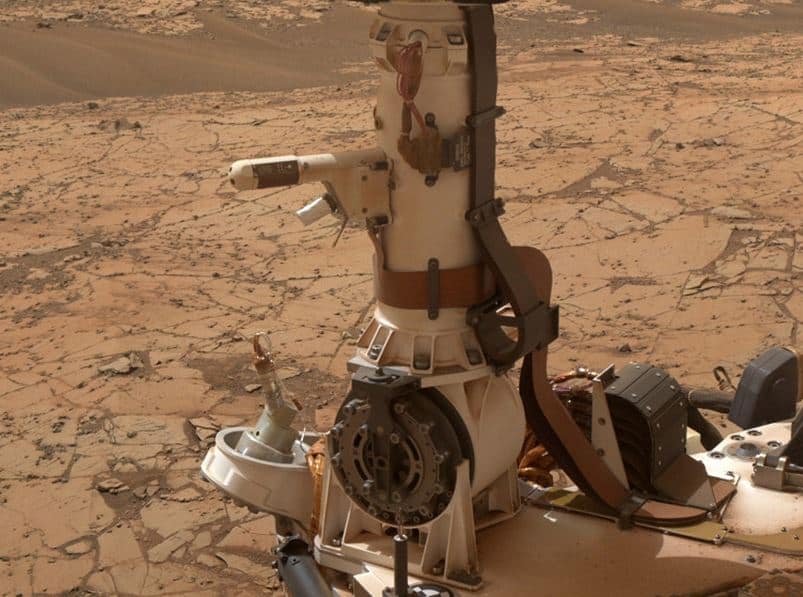Scientists have discovered evidence of water cycles present in Mars, but say that radiation and temperature levels on its surface make it highly unlikely that life as we know it exists on the Red Planet. However, the environment may be less inhospitable deeper down below the surface.
Scientists wrote in the academic journal Nature Geoscience (citation below) that they discovered brines in Mars that evaporate during the night, proving that a water cycle exists in the planet.
Lead author, Professor Javier Martín-Torres, who works at Luleå University of Technology in Sweden, and is also a member of Curiosity’s science team and the Spanish Research Council, said:
“For the first time, we have found conditions for the existence of liquid water on Mars.”

Data from the Rover Environmental Monitoring Station (REMS) underlie the conclusions made by the scientists in this latest study. (Image: NASA)
Martian weather and soil conditions measured by NASA’s Curiosity rover, together with a kind of salt found on the Red Planet’s soil, could put liquid brine in the soil at night.
Perchlorate found in Martian soil
Curiosity identified perchlorate in the Martian soil, which has properties for absorbing water vapor from the atmosphere and reducing the temperature at which water freezes. Perchlorates are the salts derived from perchloric acid.
For years, this had been proposed as a mechanism for possible existence of transient liquid brines at higher latitudes on Mars, despite its dry and very cold conditions.
According to calculations of more than a full Mars year of temperature and humidity measurements, conditions at the rover’s near-equatorial location were favorable for small amounts of brine to form during some nights throughout the year, drying out again after the sun came up.
More water likely at higher latitudes
At higher latitudes (further away from the equator) conditions should be even more favorable, where lower temperatures and more water vapor can result in more frequent episodes of higher relative humidity.
Prof. Martín-Torres said:
“Liquid water is a requirement for life as we know it, and a target for Mars exploration missions. Conditions near the surface of present-day Mars are hardly favorable for microbial life as we know it, but the possibility for liquid brines on Mars has wider implications for habitability and geological water-related processes.”

Image from the ‘Hidden Valley’ in Gale Crater on Mars. Evidence suggests that the entire Gale Crater may have been a large lake. (Credit: NASA/JPL, MSSS)
Co-author, Curiosity Project Scientist Ashwin Vasavada, of NASA’s Jet Propulsion Laboratory, Pasadena, California, said:
“We have not detected brines, but calculating the possibility that they might exist in Gale Crater during some nights testifies to the value of the round-the-clock and year-round measurements REMS is providing.”
Curiosity is the first mission to measure relative humidity in the atmosphere of Mars close to the surface and ground temperature 24 hours per day across all the seasons of the Red Planet’s year.
Relative humidity depends on how much water vapor is in the air, as well as its temperature. According to Curiosity’s measurements, relative humidity in Mars ranges from about 5% on summer afternoons to 100% in winter and autumn nights.
Perchlorate salts become dissolved in liquids
Air within pores in the soil interacts with air just above the ground. When its relative humidity rises beyond a threshold level, salts can absorb enough water molecules to become dissolved in liquid, a process known scientifically as deliquescence.
Perchlorate salts are very good at this. Perchlorate has been identified at near-equatorial and near-polar sites, so one can logically conclude it is present in soils across the planet.
Scientists using the HiRISE (High Resolution Imaging Science Experiment) camera on NASA’s Mars Reconnaissance Orbiter have documented several sites on Mars where dark flows appear and extend on slopes during the warmer months. These features are called RSL (recurring slope lineae). Scientists hypothesize they occur when brine is formed by deliquesence.
Co-author, HiRISE Principal Investigator, Alfred McEwen, who works at the University of Arizona, Tucson, said:
“Gale Crater is one of the least likely places on Mars to have conditions for brines to form, compared to sites at higher latitudes or with more shading. So if brines can exist there, that strengthens the case they could form and persist even longer at many other locations, perhaps enough to explain RSL activity.”
Life on Mars not likely
On the Martian surface and five centimeters down, conditions for life as we know it are unfavorable, due to very strong radiation and mean temperature values.
Scientists say that perhaps the environment is more favorable for life deeper down below the five centimeter level. “In that case, it could be a possible refuge for life, domestic or brought to Mars from Earth, but we do not know. For life as we know it, it would be very difficult to survive on Mars,” says Prof. Martín-Torres.
Prof. Martín-Torres believes the latest findings presented in the journal will help in the planning of future explorations of Mars.
Citation: “Transient liquid water and water activity at Gale crater on Mars,” F. Javier Martín-Torres, María-Paz Zorzano, Patricia Valentín-Serrano, Ari-Matti Harri, Maria Genzer, Osku Kemppinen, Edgard G. Rivera-Valentin, Insoo Jun, James Wray, Morten Bo Madsen, Walter Goetz, Alfred S. McEwen, Craig Hardgrove, Nilton Renno, Vincent F. Chevrier, Michael Mischna, Rafael Navarro-González, Jesús Martínez-Frías, Pamela Conrad, Tim McConnochie, Charles Cockell, Gilles Berger, Ashwin R. Vasavada, Dawn Sumner & David Vaniman. Nature Geoscience. Published 13 April, 2015. DOI: 10.1038/ngeo2412.
